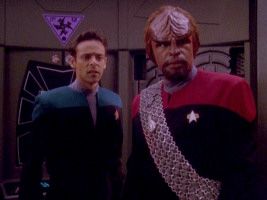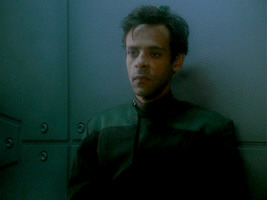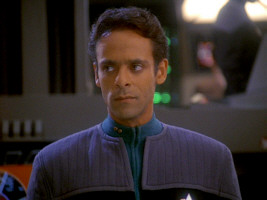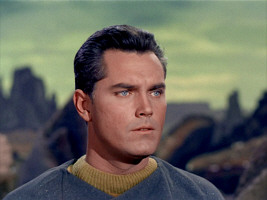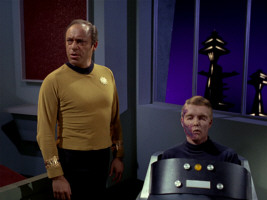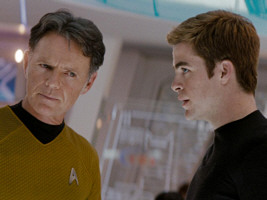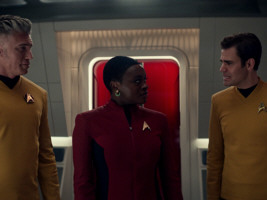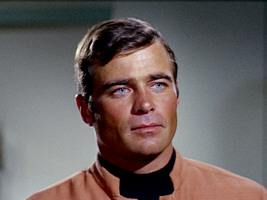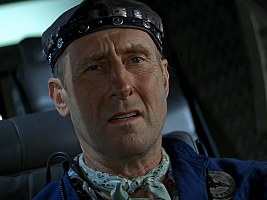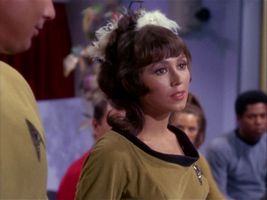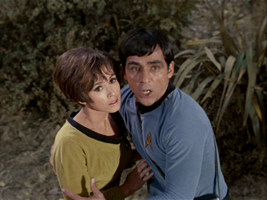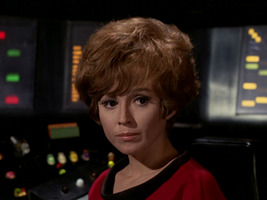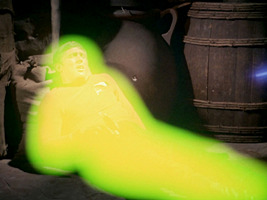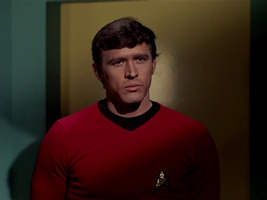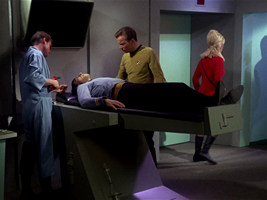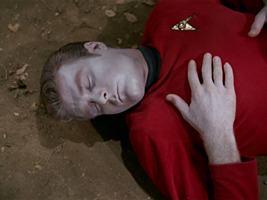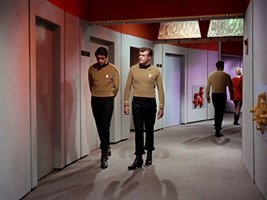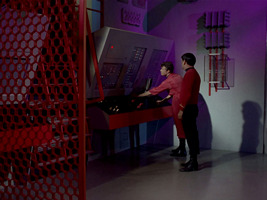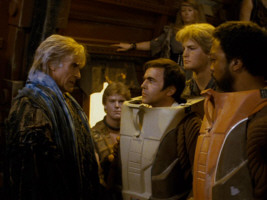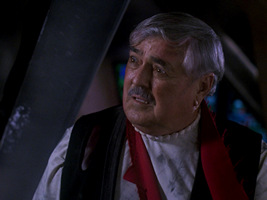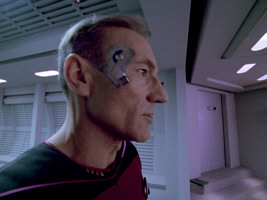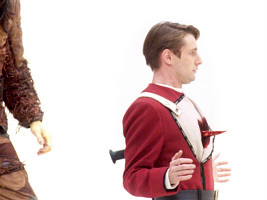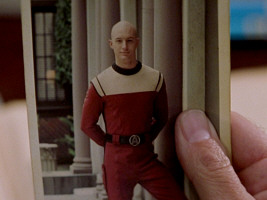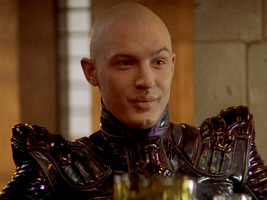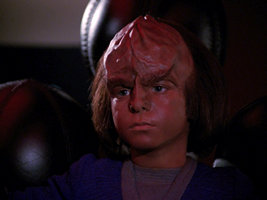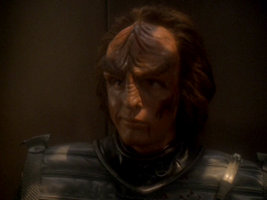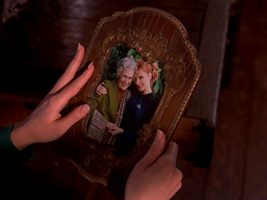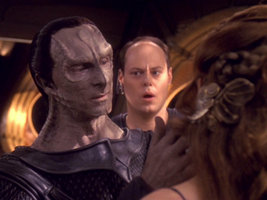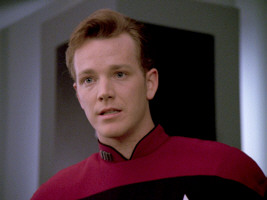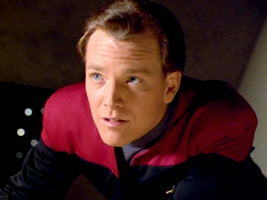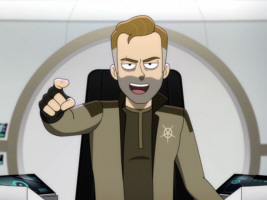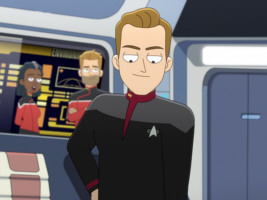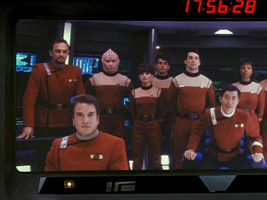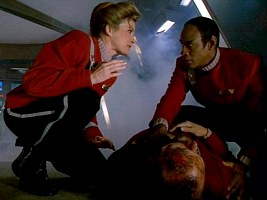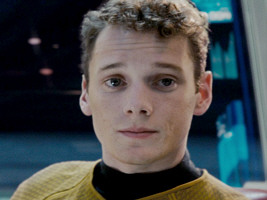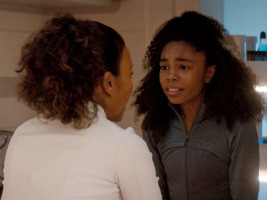Biography Inconsistencies
The Bashir ChangelingThe Starfleet OrphanageOther Biography Problems
The Bashir Changeling
by Maciej Zinczuk [Jonathan Doorse]
In DS9: "In Purgatory's Shadow" we find out that Doctor Bashir was kidnapped by the Dominion and replaced by a Changeling a month prior to the episode. The purpose of this article is to analyse the supposed episodes with the Changeling Bashir in order to find if any of them contained "character development" moments (and are therefore subject to being considered inconsistencies) and determine the point at which Bashir was kidnapped.
The captured Bashir wore the old-style uniform in "In Purgatory's Shadow". "Rapture" is the first DS9 episode with the "First Contact" uniforms.
Thesis
Bashir was kidnapped between "The Ascent" and "Rapture". Therefore, the following episodes would need to feature the Changeling Bashir:
- 108 Rapture (stardate n/a)
- 109 The Darkness and the Light (stardate 50416.2)
- 110 The Begotten (stardate n/a)
- 111 For the Uniform (stardate 50485.2)
- 112 In Purgatory's Shadow (stardate n/a)
- 113 By Inferno's Light (stardate 50564.2)
It is, of course, possible that Bashir was kidnapped even earlier. However to minimise the number of episodes with the Changeling Bashir I would find it suitable if it was as stated above. I refuse to believe that Bashir was a Changeling in "Trials and Tribble-ations". Also, one month would equal only 83 stardate units, maybe about 100 if we are generous with the accuracy of that statement. Therefore the analysis will only include occurrences following this episode.
105 Let He Who Is Without Sin...
I would really hate for Bashir to be a Changeling in this episode. His involvement in the story is very personal. When Worf and Jadzia decide to go to Risa, he and Leeta decide to go with them. Quark joins the four to Worf's dismay. For a Changeling to want to go to Risa, which is apparently not a strategically important location in the UFP, would be illogical. If he wanted to infiltrate another Starfleet installation, it would not likely be Risa. Besides, it was apparent that this Changeling's mission was to infiltrate DS9, so he would likely try to avoid leaving DS9 (within reason). It is also worth noticing that Bashir and Leeta are having sexual relations at this time. To which possibility the following quote alludes:
Leeta: "What's this?"
Bashir: "It's a horga'hn. A Risian fertility symbol."
Quark: "Displaying one to the locals indicates you're seeking jamaharon."
Leeta: "What's jamaharon?"
Bashir: "I'll show you later."When on Risa, Worf is reluctant to enjoy himself. He is tempted by the Essentialist movement which condemns the Risian pursuit of pleasure. The movement is led by a man named Fullerton, who claims that this weakens the Federation. It is worth noting that Bashir does not support Fullerton's views. If one wanted to claim that this was the Changeling then opposing a faction that wants the UFP to focus more on defense than pursuit of pleasure would be in the Changeling's best interest. This theory, however does not make sense after a more thorough analysis. First of all, pretty much everyone was against Fullerton, and Bashir's anti-Fullerton statements were not anything out of the ordinary. Second of all, Fullerton's bunch was really little more than malcontent conservatives. Politically the level of danger they represented was negligible, only their terrorist activities made them a threat to the Federation.
It is interesting that Worf, upon learning that Bashir and Leeta are dating other people, saw this as evidence that they are cheating on one another and was willing to blame Risa for what he considered dishonorable behaviour. Worf's incorrect conclusion was based on his lack of knowledge about the true purpose of their visit to Risa. Bashir and Leeta went to Risa to end their relationship. In a rather elaborate, time-consuming and completely process redundant for somebody trying to impersonate Bashir. Not to mention that Leeta would've likely noticed if Bashir was a Changeling. It's one thing to fool O'Brien and the rest, and another thing altogether to fool somebody you're very close to and intimate with. I seriously doubt even a Changeling could've achieved that. Another question entirely is whether a Changeling would be able to impersonate a solid during sexual intercourse. It may be possible.
Later in the episode Bashir and Leeta conduct a Bajoran separation ceremony. While a Changeling Bashir definitely would've wanted to separate himself from the people closest to the real Bashir (as naturally as possible), I don't think he would've gone to such great lengths. Not to mention that events from future episodes confirm that it was indeed Bashir that broke up with Leeta (or rather they broke up with each other). Upon learning of Leeta's attraction to Rom, Bashir's reaction is... genuine confusion and when Leeta and Quark leave he looks very sad. Not that a Changeling couldn't have achieved that. However, why would he need to, in that relative privacy. Bashir's conversation with Quark and Jadzia touches the subject of his attraction to Jadzia, that however is not anything that wasn't common knowledge.
I believe there is sufficient proof to claim with fair certainty that this episode does indeed feature the real Bashir.
106 Things Past
Bashir's involvement in the events of this episode only include his professional side. Which would leave no problem if he was a Changeling. However, due to the unusual nature of the medical emergency, I would prefer him to be the real Bashir. Granted, the Changeling Bashir will also perform complex medical procedures in "Rapture", but this is at least one more reason for him to be real. After all, the fewer complex medical procedures Changeling Bashir performs altogether, the more believable he is. The revelation about Odo's not entirely solid nature would be a significant one for the changeling Bashir (if Bashir was to be the Changeling). And even then he couldn't reveal his true opinions because to do so would mean to endanger the mission. Still, considering the unique nature of this unprecedented situation, especially for a shapeshifter, it is possible that he would've slipped. I find it highly improbable that the Changelings were aware that the "Great Link" can be done with solids, or that they had any such experiences through their history.
Also, this is still well on the side of "colourful" uniforms, so this should be the real Bashir.
107 The Ascent
In this episode Bashir has only several speaking lines, at the very end. It would be acceptable if he was a changeling, due to his rather routine nature of his involvement. Of course, this this the last episode with "colourful" uniforms, so he could still be himself.
108 Rapture
In this episode Bashir is in no way personally involved with the story, however his medical expertise is being put to use. Never does he act out of character (not to me, anyway). This puts forth a question of how a Changeling managed to efficiently impersonate the Chief Medical Officer. Much more skill is required than when impersonating someone for a short time. Even if there were no other serious medical crisis all through the month (like that would happen), and he used his assistant for minor jobs, there still would be some situations in which his skills would be needed. The Changeling Bashir talks of neuro-polaric Induction, which is a serious procedure. I would expect only qualified doctors know how to conduct such a procedure, and that it is not a widely talked about operation that one can find out from basic medical study books. Also, associating symptoms with a possible treatment is another thing altogether. Later in the episode Bashir talks about his medical ethics. When it comes to treat a patient without his consent. Granted, medical ethics are easier to imitate (if not learn) than medical skills, but it was still a convincing performance.
109 The Darkness and the Light
In this episode Bashir is in no way personally involved with the story, however his medical expertise is being put to use.
110 The Begotten
Since this episode most definitely features the Changeling Bashir, it must've been difficult for him not to show unusual interest in the infant Changeling. Much like in "Things Past", this features something that, I'm assuming, does not happen often to a Changeling. Finding one of "the hundred" sent away so long ago. Still, it is apparent that despite the claim that one Changeling is more important than the entire Alpha Quadrant, Founders are willing to sacrifice some, for the "greater good". It also happened in "The Adversary" and "By Inferno's Light".
During Kira's ceremony Bashir leaves, claiming to have a lot of work. This is still believable, but it is possible that he had other reasons to leave. The Changeling Bashir's reaction to the infant Changeling's sickness should be sadness. As for whether he would feel anger that the infant integrated himself with Odo, the traitor (Changeling Martok was angry with Odo), or more accepting of the situation (like the female Founder) is anybody's guess. Although its worth noting that Changeling Martok was dealing with solid Odo and the female Founder with Changeling Odo.
111 For the Uniform
Bashir does not appear. Good.
112 In Purgatory's Shadow
In the beginning we have what seems to be a little character development for Bashir. Especially considering his relationship with Garak. The Bashir-Garak conversation seems just right. Also considering Bashir's interest in spy stories. The waiting for Garak in the runabout was very James Bond-ish. Also, the Changeling Bashir knows a lot of the conversations he had with Garak in the previous years. After Bashir is revealed, it is a part of the storyline.
113 By Inferno's Light
The Payoff. The Changeling Bashir is a part of the storyline.
Conclusion
Another possibility is that Bashir changed to a different uniform for the medical conference. That is, however, unlikely. There is apparently no such tradition. For example, in "Rapture", Starfleet officers who arrived on DS9 did not change into DS9-gray uniforms. Between "The Ascent" and "Rapture" is likely the time when Bashir is kidnapped. Also, this is five episodes before it is revealed. Bashir was to spend a bit more than a month in the Dominion Internment Camp. One week per episode. Although the time in the show does not always flow parallel to real time, it may be true that an episode and the gap between it and the next one do correspond to about a week.
DS9: "Inquisition" confirms this conclusion. Here Sloan mentions that Bashir spent five weeks in the Dominion prisoner camp, and Bashir says that it was exactly 37 days. This would still leave the possibility that Bashir was kidnapped one or even two weeks earlier, but for the sake of simplicity we may assume that he was transferred to the camp immediately, and that he might count in the days he must have spent on a prisoner transport.
The Starfleet Orphanage
Life in the 23rd and 24th century is usually described as being without any danger. Deadly diseases have been largely eliminated, technical devices are almost totally safe (which is why Barclay's transporter psychosis in TNG: "Realm of Fear" is not taken seriously), and the crime rate on Earth is zero (VOY: "The Cloud"). Life expectancy of humans is supposed to be a hundred years or more. This general statement is in contrast to the events in Star Trek where wars, criminal acts, plagues, "rare" diseases, transporter or shuttle accidents are very common.
This is still plausible as far as Starfleet personnel is concerned, after all they are supposed to boldly go on dangerous missions. Moreover, such an explicitly called "exceptional case" of a disease or accident is often an essential part of the plot. The most endangered group, however, appears to be that of relatives of the Star Trek main characters, no matter if they are civilians or Starfleet officers themselves. Very few of them seem to have died of old age:
- McCoy's father dies from an incurable disease ("Star Trek: The Final Frontier").
- Jim Kirk is one of the few survivors of Tarsus IV, and it is quite possible he also loses relatives during the crisis (TOS: "The Conscience of the King"). His brother George and sister-in-law Aurelan are killed in the attack of the parasites on Deneva (TOS: "Operation: Annihilate"). Kirk's son David is executed by the Klingons ("Star Trek: The Search for Spock").
- The previous Dax host Torias dies in a shuttlecraft accident (DS9: "Shadows and Symbols").
- The circumstances of the death of Will Riker's mother are uncertain, but considering his young age it is obviously before her time (TNG: "The Icarus Factor").
- Deanna's sister Kestra drowns in a lake (TNG: "Dark Page"). Her father, Ian Andrew Troi, dies unexpectedly a few years after Deanna's birth (TNG: "Half a Life").
- Deanna and Will's son Thaddeus Troi-Riker dies of mendaxic neurosclerosis, a very rare infection with a silicon-based virus that could have been cured by culturing infected cells in an active positronic matrix (PIC: "Broken Pieces").
- Worf's parents are killed in the Romulan attack on Khitomer (TNG: "Sins of the Father"). As if this were not enough grief, he loses K'Ehleyr (TNG: "Reunion") and Dax (DS9: "Tears of the Prophets") too, who are both murdered.
- Tasha's parents are killed on the anarchic planet Turkana IV (TNG: "Legacy").
- Kira's parents die during the Cardassian occupation (DS9: "Ties of Blood and Water", "Wrongs Darker than Death or Night").
- Jack Crusher is killed on an away mission (TNG: "Encounter at Farpoint", "The Bonding"). Years prior to that, Beverly apparently loses her family, with the exception of her grandmother Felisa, when a plague strikes Avada III (TNG: "The Arsenal of Freedom"). Felisa Howard herself dies of old age though (TNG: "Sub Rosa").
- Seven's parents are practically dead after their assimilation (VOY: "The Raven"). She later loses Icheb, who is much like family to her (PIC: "Stardust City Rag").
- Janeway's father drowns on Tau Ceti Prime (VOY: "Coda").
- Neelix's family, including his sister Alixia, are killed in the war with the Haakonian Order (VOY: "Rise").
- Jennifer Sisko is killed in the battle against the Borg at Wolf 359 (DS9: "Emissary") - and again in the Mirror Universe (DS9: "Shattered Mirror"). Moreover, Ben's biological mother Sarah dies in a hovercar accident (DS9: "Image in the Sand").
- Geordi's mother is missing and presumed dead together with her starship, the USS Hera (TNG: "Interface").
- Picard's brother and nephew die in a fire ("Star Trek: Generations"). His mother commits suicide when he is still a boy (PIC: "Hide and Seek").
- The Doctor's daughter Belle dies after a parrises squares match (VOY: "Real Life"). Agreed, she has been programmed by B'Elanna to die, but it was supposed to be just what the episode title says.
- The death of Mayweather's father is unexpected (ENT: "Horizon").
- Henry Archer seems to have died years prior to the first flight of his prototype. He must have been well under 60 (ENT: "First Flight").
- Trip's sister Lizzy loses her life in the Xindi attack (ENT: "The Expanse").
- T'Pol's mother T'Les dies when the High Command attacks the Syrranites (ENT: "Awakening").
 Kirk loses his father in Nero's attack on the Kelvin ("Star Trek (2009)").
Kirk loses his father in Nero's attack on the Kelvin ("Star Trek (2009)").- Spock's mother is killed in the destruction of Vulcan ("Star Trek (2009)").
 Michael Burnham loses her parents in a Klingon attack (although for some reason her mother survives) and is raised by Sarek of Vulcan (DIS: "The Vulcan Hello", "Battle at the Binary Stars").
Michael Burnham loses her parents in a Klingon attack (although for some reason her mother survives) and is raised by Sarek of Vulcan (DIS: "The Vulcan Hello", "Battle at the Binary Stars").- Just after their honeymoon, Airiam loses her husband in a shuttle crash (DIS: "Project Daedalus").
- Jett Reno's wife dies in the war against the Klingons (DIS: "Through the Valley of Shadows").
- Adira loses Gray Tal in an asteroid crash, only the Tal symbiont survives in Adira's body (DIS: "Forget Me Not"). Some time later, the Gray host can be isolated and implanted into a new synthetic body (DIS: "Choose to Live").
- Booker's whole family dies as the DMA strikes his home planet Kwejian (DIS: "Kobayashi Maru").
- La'an Noonien-Singh is the only survivor of her family, which was eaten alive or used as breeding sacks by the Gorn (SNW: "Strange New Worlds").
- Uhura was going to the University of Nairobi. A week before she was going to start, her parents and her brother were killed in a shuttle accident (SNW: "Children of the Comet").
- Joseph M'Benga lost Debra, Rukiya's mother, well before her time (SNW: "The Elysian Kingdom").
- Christopher Pike's father was not much older than 50 when he died (SNW: "Those Old Scientists").
- Christine Chapel was still a child when her mother died (SNW: "Wedding Bell Blues").
- Erica Ortegas lost her mom at a young age because of a disease (SNW: "What is Starfleet?").
 It appears that almost all protagonists of Star Trek: Prodigy are orphans (PRO: "Lost and Found").
It appears that almost all protagonists of Star Trek: Prodigy are orphans (PRO: "Lost and Found").
Nothing of the above is really inconsistent, only the accumulation of premature and unnatural deaths in the back stories of the main characters is not plausible. Every second of them seems to have lost close relatives in an "unlikely" accident or war or through a "rare" disease.
Other Biography Problems
Pike's age
How old is Captain Pike? He captained the Enterprise in "The Cage" in 2254, so he must have been over 30 at that time. Jeffrey Hunter, who played Pike, was 38 when the first pilot episode was produced (1964). So far, so good. Flash forward to "The Menagerie I", which takes place in 2267, some 13 years later. Here Kirk meets the disabled Pike, now played by another actor, whose age in his role is hard to estimate because of the "radiation damage" make-up. Commodore Mendez states that Pike is about Kirk's age. William Shatner was 36 when he filmed "The Menagerie I" (1966). So the statement doesn't sound right, considering that Pike should be around 50, which is hardly the same age. Yet, the question of his age was a rather small issue until Pike was rebooted - two more times.
 In "Star Trek (2009)" it is blindingly obvious that Pike and Kirk are not the same age. At the time the reboot movie was produced, Bruce Greenwood (Pike) was 52 years old; Chris Pine (Kirk) was just 28. Here, Admiral Pike is the fatherly friend of Kirk, at a time (2258) when the latter is still a cadet and his Prime Universe counterpart must have been a lieutenant (just as it would be established in Strange New Worlds season 2, which takes place in 2259). This doesn't fit with "The Menagerie I".
In "Star Trek (2009)" it is blindingly obvious that Pike and Kirk are not the same age. At the time the reboot movie was produced, Bruce Greenwood (Pike) was 52 years old; Chris Pine (Kirk) was just 28. Here, Admiral Pike is the fatherly friend of Kirk, at a time (2258) when the latter is still a cadet and his Prime Universe counterpart must have been a lieutenant (just as it would be established in Strange New Worlds season 2, which takes place in 2259). This doesn't fit with "The Menagerie I".
 The third Pike is portrayed by Anson Mount in Discovery season 2 and in Strange New Worlds. Mount was 45 when he played the character on Discovery, and hence some seven years younger than Greenwood's Pike at the same time in the Kelvin Timeline. In "Lost in Translation" in SNW season 2, Mount's Pike (now 49) encounters Paul Wesley (40) as Kirk. These two are much closer together, more like they realistically were in TOS. Yet, SNW creates a new continuity problem with regard to Pike because Kirk runs into him over and over again in the course of the series and knows him very well, although Kirk's statement in "The Menagerie I" clearly indicated they only met once or twice. This issue is discussed in the scope of the Discoverse Continuity.
The third Pike is portrayed by Anson Mount in Discovery season 2 and in Strange New Worlds. Mount was 45 when he played the character on Discovery, and hence some seven years younger than Greenwood's Pike at the same time in the Kelvin Timeline. In "Lost in Translation" in SNW season 2, Mount's Pike (now 49) encounters Paul Wesley (40) as Kirk. These two are much closer together, more like they realistically were in TOS. Yet, SNW creates a new continuity problem with regard to Pike because Kirk runs into him over and over again in the course of the series and knows him very well, although Kirk's statement in "The Menagerie I" clearly indicated they only met once or twice. This issue is discussed in the scope of the Discoverse Continuity.
Perhaps Commodore Mendez claims that Pike and Kirk are the same age "The Menagerie I" because he himself is much older? But that doesn't really work out. Malachi Throne, who portrayed JosÚ Mendez, is barely three years older than Shatner. Well, we may argue he looks older because he is not wearing a toupee. Anyway, the error was already with "The Menagerie I", although "Star Trek (2009)" arguably worsened it.
James R Kirk
In TOS: "Where No Man Has Gone Before", Gary Mitchell uses his powers to create a grave and headstone for Captain Kirk. The stone clearly reads "James R Kirk". Kirk's name, however, is firmly established as "James T. Kirk". The middle initial "T" is used consistently throughout The Original Series after the second pilot. The full name "James Tiberius Kirk" is revealed in TAS: "Bem" and reaffirmed in "Star Trek: The Undiscovered Country".
At the time the headstone with the "R" was built, the middle initial "T" of James Kirk may not have been finalized yet. The error of the name in the scripts not matching the one on the prop was either ignored or noticed too late. According to D.C. Fontana, Gene Roddenberry decided that if pressed for an in-universe explanation of the discrepancy, the response was to be "Gary Mitchell had godlike powers, but at base he was human. He made a mistake." The non-canon Star Trek Continues episode "To Boldly Go" aptly picks up this rationale when Kirk says about Mitchell: "He couldn't even remember my middle name."
Overall, the "James R. Kirk" headstone is a minor production slip that's easy to explain away, that never affected canon and that's simply not worth digging into too deeply. Yet, it's often inflated into a poster child for the flaws of classic Star Trek, recently treating it as equivalent to the sweeping contradictions in the Discoverse. Obsessing over Kirk's middle initial trivializes the real stakes of continuity.
Zefram Cochrane, "of Alpha Centauri"
In TOS: "Metamorphosis" we get acquainted with Zefram Cochrane, the inventor of warp drive. He lives with a non-corporeal entity, the "Companion", on a secluded planet. Captain Kirk, astounded to find the warp pioneer alive after such a long time, incredulously asks, "Zefram Cochrane, of Alpha Centauri?" Many fans took it for granted that Cochrane was not human but a native of the star system about four light years from Earth. In "Star Trek: First Contact", however, Cochrane is undeniably human, and no human at that time (2063) has ever met aliens, much less traveled to an alien world.
Well, we are lucky that Brannon Braga, who was unaware of the TOS episode, didn't switch Cochrane's gender as he had originally planned for the movie... Anyway, Cochrane was never intended to be an alien. As a matter of fact, a couple of minutes before the line about Alpha Centauri in TOS: "Metamorphosis", Cochrane himself says he is pleased to meet people who speak English and who come from Earth. And McCoy states that the man they have found is human. And he has a human name too. So the idea that he could be an alien is a totally baseless myth right from the start. The idea probably came into existence in the (non-canon) book Spaceflight Chronology, where an Earth ship arrives at Alpha Centauri and makes first contact with Zefram Cochrane.
The apparent inconsistency that he is not called "Cochrane, from Earth" doesn't have to be one if we assume that Cochrane, after building a long-range warp ship, eventually moved to Alpha Centauri. But considering that Kirk is speaking of Alpha Centauri like a distinguishing mark, we would expect Cochrane to have lived and worked there for a long time to be still remembered as a resident of the star system 150 years later.
In ENT: "Future Tense" the story is wrapped up when an apparently human body is found in deep space and Archer hypothesizes that it could be Zefram Cochrane, who has disappeared decades ago. Alpha Centauri is not mentioned in this episode though. But considering that in 2119 he was still present at the opening of the Warp Five Complex (ENT: "Broken Bow") and had obviously been working on that project with Henry Archer all the time, this leaves almost no time for Cochrane to resettle to Alpha Centauri and vanish from there. Actually, the year of his disappearance would be as soon as 2117 according to TOS: "Metamorphosis", but we must understand this as an approximate date anyway.
Aside from Kirk's line about his origin the most obvious inconsistency in Cochrane's biography remains the change of his appearance. The young Cochrane of the TOS episode, played by Glenn Corbett, looks nothing like James Cromwell's character in "Star Trek: First Contact". We may explain this only in that the Companion, who rejuvenated Cochrane, must have taken some liberties. On the other hand, Kirk and McCoy both say that Cochrane looks familiar to them. Maybe the Companion obstructed everyone's perception, like the "salt vampire" did in TOS: "The Man Trap"? What's more, if Cochrane was 87 when he disappeared around 2117, he must have been born around 2030. No offense to James Cromwell, but he really didn't look like 33 in "First Contact". Maybe Cochrane suffered radiation damage that made him age more rapidly?
Angela Martine-Teller-Lisa?
Barbara Baldavin plays the brunette Angela Martine in TOS: "Balance of Terror", whose future husband Robert Tomlinson is tragically killed in the battle with the Romulan ship. The same actress reappears among the landing party in "Shore Leave", where her first name is once again Angela, but her last name is Teller and her hair is more reddish now. On both occasions she appears in a yellow uniform of an enlisted crewperson or ensign (no rank signs). Barbara Baldavin can be seen one more time in TOS: "Turnabout Intruder". Here she replaces Lieutenant Uhura as the ship's communication officer, and her uniform is accordingly red. While her first name isn't mentioned here, the last name of the character has to be Lisa, because she is repeatedly referred to as "Lt. Lisa". Is Lisa still the same person?
There is no problem with the uniform switch from yellow to red. Lisa or whatever her last name was at the time may have been transferred from Command to Operations at some point. Even if she was acting as the ship's communication officer only temporarily, she may have switched to the red uniform on that occasion. We have seen other crew members in temporary uniforms, such as security officer Lt. Leslie in yellow when he occupied the navigator's position in "The Changeling". Also, it is comparably fast but still plausible that if she was an ensign at the time of "Shore Leave", after roughly two years Angela may have been promoted to the rank of full lieutenant, which may have involved a transfer to another department. Angela Martine/Teller may have decided to dye her hair red, a style that she kept as Lt. Lisa. So the tricky part to explain away is why she changed her name even twice. Perhaps she had been married before to a person named Martine, and after the death of Robert Tomlinson, whom she almost married in "Balance of Terror", she decided to return to her birth name Teller. And in the two years between "Shore Leave" and "Turnabout Intruder" there would have been plenty of time to get married again, apparently to a person with the last name "Lisa". Angela does seem to have a peculiar predilection for female first names as last names. :-)
Galloway's death
Lt. Galloway is an unfortunate redshirt, who was definitely killed in TOS: "The Omega Glory". There is not the slightest doubt about his death, because Capt. Tracy vaporized him with a phaser. Yet, in TOS: "Turnabout Intruder" David L. Ross, who played Galloway, is once again a lieutenant of the ship's security. And his character is credited as "Galoway" (with only one "l") in the episode's credits.
Perhaps we should neglect the misspelling of the name in the "Turnabout Intruder" credits, as a slightly different name wouldn't alleviate the problem in any fashion. The security officer in this episode was definitely meant to be the same Galloway. Unless we want to resort to some temporal anomaly theories, either Galloway has a twin brother that is still alive, or there is another officer who looks amazingly like him. We've had several actors who played multiple roles and looked essentially the same in all of them, most notably Diana Muldaur who guest starred as Dr. Mulhall in "Return to Tomorrow" and as Miranda Jones in "Is There in Truth No Beauty?". Only the fact that Galloway and the other guy are both security lieutenants is rather odd. But overall these two roles are small enough to neglect the coincidence.
Leslie's strange career and death
The security officer named Leslie (played by Eddie Paskey) dies in TOS: "Obsession" when the dikironium cloud extracts the erythrocytes from his body. Quite a few of the actors playing security officers such as Galloway also returned from the dead. The particular dilemma with Leslie is that after his definite death in "Obsession" he can be seen prominently and frequently, and his name is called out a couple of times. He is one of the most often recurring characters of TOS with over 50 appearances in total, before and after his death. In the course of this tenure, Leslie also appears as a navigator or helm officer, as an engineer or technician and as a medical assistant. Although he mostly wears a red shirt, he can be seen with all three colors for that matter.
It is very unlikely that Kirk could have declared Leslie dead prematurely. His pale face insinuates that he is missing far too many erythrocytes to be still alive (unlike Rizzo whose face still looks healthy and who dies nonetheless). Also, Kirk later confirms that two crewman have died. Since Rizzo is still alive at the time, he must refer to the unnamed security officer and Leslie.
There may be two characters (twins?). This would also alleviate the other problem, that Leslie occupies so many different positions. Curiously, we can see Leslie with a red engineering suit and, in a different shot, with a yellow shirt during Kirk's announcement in "Assignment: Earth". This clearly indicates that these two should be considered different people. Yet, this observation doesn't really help regarding the issue of his death, since "Assignment: Earth" takes place after "Obsession".
Who commanded the Enterprise in 2269/2270?
In "Star Trek: The Motion Picture", Admiral Kirk says he has been the Chief of Starfleet Operations for two and a half years. Decker later adds that Kirk hasn't been on the Enterprise at all during that time. Scotty, on the other hand, states, "We have spent eighteen months refitting the ship." Since Kirk can't have been in command, there should have been another captain for a full year while the ship was still in service (supposing that the two stated figures are not off by more than half a year). We know from his own statement, which is confirmed by an alien crew member, that Willard Decker has been present during the entire refitting phase. But did he previously command the ship for a one-year mission in space?
Decker had been on Delta IV an unspecified number of years earlier, so he would be a candidate. Spock was still a commander, and he may already have been on Vulcan to perform the kolinahr. It could have been as well a yet unknown captain who commanded the ship in space. Another explanation is that the Enterprise was mothballed during that year and had a temporary captain (maybe Scotty), or that Scotty didn't count in the time to disassemble the ship prior to rebuilding it. The most obvious explanation is that Scotty may have explicitly referred to himself working on the ship for the last eighteen months, so he may just not have been present during the first year of the work, maybe for sentimental reasons, because he didn't want to witness the ship being taken apart. So it is possible that there was either a preliminary captain, most likely Decker, or none at all if the ship was mothballed or being disassembled.
Khan and Chekov
"I never forget a face, Mr. Chekov." - Even casual viewers have noticed the error that lies in this quote. When Khan hijacked the Enterprise in the first-season episode TOS: "Space Seed", the character of Pavel Chekov was not yet in the series. Chekov's first appearance was in the second season.
The easiest solution to the dilemma is that Ensign Chekov was already aboard the Enterprise during the first season and later took his seat on the bridge, probably after some time of training on the lower decks. Khan may have seen him off-screen. Still, it was a bad idea to have him of all regular crew members meet Khan in the movie. Also, as one of the few cases of intra-series continuity in TOS, Chekov does not know Harry Fenton Mudd in TOS: "I, Mudd" and he asks Kirk who the man is. Mudd previously appeared in TOS: "Mudd's Women" in the first season when Chekov was apparently not yet supposed to be on the Enterprise.
Director's comment Nicholas Meyer: "Chekov is in this scene, although he was not in the Khan episode. He was not in the series at that time, but I stuck him in. I mean, I could just have easily have switched it around, and Chekov could have been aboard the Enterprise, and Uhura could have been in this scene, and it would have been 'technically' correct. I never wasted any thought about it. By the way, if you read the Sherlock Holmes stories, which I am very familiar with, Conan Doyle made all sorts of mistakes in the Sherlock Holmes stories. Sometimes Watson refers to his wound as being in his arm, other times in his leg; Mrs. Hudson is the landlady, but one time she's 'Mrs. Turner'; and Doyle himself was quite cavalier about it and he said, 'I have never much striven for it (meaning accuracy of detail), and no doubt have made some serious blunders in consequence. What matter, so long as I hold my readers'. And I guess that's the 'Chekov defence'."
Scotty's memory of Kirk's death
This may be the most commonly known biography inconsistency. When an Enterprise-D away team finds Scotty trapped in the transporter of the Jenolan in TNG: "Relics" and Scotty hears that they come from the Enterprise, he intuitively concludes that Jim Kirk has come to his rescue: "I bet Jim Kirk himself hauled the old gal out of mothballs to come looking for me." We may concede Scotty a certain degree of confusion, but shouldn't he know that Kirk vanished in the Nexus in "Star Trek Generations" and is believed to be dead until a few years after the episode? Irrespective of possible calendar revisions the incident on the Enterprise-B where Kirk apparently died must have taken place prior to Scotty's departure on the Jenolan - obviously because otherwise Scotty would have been the missing person!
The simple real-world explanation is that the writers of "Star Trek Generations" didn't take into account that Scotty had previously mentioned Kirk as being alive in "Relics". So there is nothing left but the explanation that Scotty was indeed confused and was reliving his time on the old Enterprise (the one "without an A, B, C, or D").
Picard's age
Patrick Stewart was 47 when TNG was launched in 1987. We should assume that the character of Capt. Picard was supposed to be of about the same age as the actor, as it has always been common practice (at least with human roles; not with Vulcans, for instance). Still, we know that Picard was born in 2305, first applied for Starfleet Academy at the age of 17 in 2322, was accepted in 2323, and graduated in 2327. This would make Picard 59 years old when he assumes command of the Enterprise-D in 2364, and 74 at the time of "Nemesis". Shouldn't the writers have made Picard rather younger than Stewart, instead of twelve years older? At the time of Star Trek: Picard's first season, Jean-Luc Picard would be 94 years old. His age is not explicitly mentioned in the series but is not supposed to be retconned either.
The reason for Picard's old age seems to be a simple miscalculation. The note that Picard graduated in 2327 comes from TNG: "The First Duty" and was most likely exactly ten years too early. But it nails down his previously mentioned first year at the Academy and his birth (knowing that he was 17 when he first applied one year earlier). In TNG: "Tapestry", Q says that the incident with the Nausicaans (which must have been immediately after Picard left Starfleet Academy) was "30 years ago", although it would be 40 years, if we believe in the date of 2327. In light of extended life spans it may be a good idea that Picard would not only live longer, but would also be able to perform his duty longer than he could do (or would be allowed to do) in present day.
Picard's hair (or lack thereof)
Natural hair loss still seems to be a problem in the 24th century, or Picard is just so honest that he doesn't want his hair growth to be stimulated. Anyway, we have seen Picard with full hair in two flashbacks during TNG. The first was in TNG: "Violations", set in the 2350s, the second in TNG: "Tapestry", set in 2327. Yet, in "Nemesis" there is a photo of Picard at the Academy (obviously a photo of Tom Hardy who plays Shinzon), and here Picard is totally bald just like his Romulan clone. Also, in PIC: "No Win Scenario" he muses that his son Jack is 23 or 24 (although the boy should be more like 21 according to the chronology) and recommends that he enjoy his full hair as long as it lasts. So if young Picard was already hairless, why would he have hair from 2327 to the 2350's?
Well, either Picard lost a bet during his Academy days and had to shave his head. It is also possible that Picard who, as we know, took part in the Academy Marathon, was also a swimmer who hoped to take advantage of a hydrodynamic head. The hair grew back, until an unusually rapid natural hair loss began at about 2360. Or Picard was ashamed of his lack of hair, and he decided to wear a wig, get a transplantation, or use some sort of hair restorer just before he left Starfleet Academy. He stopped with that when he recognized that he was old enough for baldness. There is still another, but rather awkward explanation, bearing in mind that neither "Violations" nor "Tapestry" were real, but actually a combinations of memories and hallucinations. Maybe Beverly (in the first case) and Picard himself (in the second case) just wanted to see him with hair. We also have to consider Boothby's remark "What happened to your hair?" when Picard visited the Academy in TNG: "The First Duty". So Picard obviously had hair when he last met Boothby, which, as we can tell from their dialogue, was very long ago, perhaps in Picard's Academy days.
Side note Patrick Stewart told us at the Galileo 7 Con 2004 that he lost his hair at the age of 19.
Picard's heart
Picard's artificial heart is in the focus of two episodes. In TNG: "Samaritan Snare" he reveals to Wesley that his natural heart was injured in a fight with Nausicaans, and that he has an artificial heart in his chest that is going to be replaced. In TNG: "Tapestry" Picard dies because this artificial heart fails after it has been hit by an energy discharge, and Q welcomes him to the afterlife (or so he tells Picard). Q gives Picard the opportunity to go back and avert the confrontation with the Nausicaans to save his heart and his life. Ultimately, however, Q restores Picard's old life. It appears that Q eventually doesn't give him back his natural heart and doesn't repair the artificial one either but that Beverly manages to save his life. It is never hinted at again though. Actually, his artificial heart is never shown or mentioned in any fashion in any other episode. It should have played a role on these occasions:
- When the Borg assimilate Picard, they supplement or replace all kinds of stuff in his body with Borg technology. It seems very unlikely that they would want their spokesmen Locutus with a crude piece of human technology (as Q will put it too) to support his life. For all we can imagine, Picard should have kept a Borg implant after the incident. Well, considering that "Tapestry" takes place afterwards, it appears that the Borg didn't bother giving him a Borg heart though.
- TNG: "All Good Things" deals with a temporal reversion, in which Geordi (who has never had working eyes in the first place) suddenly regains his sight and Ogawa loses her unborn baby. Why doesn't Picard's artificial heart just flop out of his chest onto the deck?
- "Star Trek: Insurrection" deals with metaphasic particles, owing to which Geordi (again) gains normal vision. But again, Picard doesn't have discomfort or his heart doesn't start to regenerate. Well, his hair doesn't grow back either.
Many years alter, in PIC: "Nepenthe", Picard says that he still has his cardiac implant. We may speculate that the "new" Picard has a natural (sort of) heart again since "Et in Arcadia Ego II".
All this is not necessarily inconsistent. But it may have been alluded to in some fashion what would happen to Picard's artificial heart under such unusual circumstances. Moreover, especially Picard with a Borg heart would have opened interesting story opportunities.
Data's Starfleet Academy graduation date
In "Encounter at Farpoint", Data tells Riker that his rank as lieutenant commander isn't honorary, and that he graduated "Class of '78, probability, mechanics, and exobiology." What is that supposed to mean? "Class of '78" as in "2278"? It seems so at the time of the pilot episode. In contrast, the later episodes "Datalore" and "Brothers" unmistakably establish that Data must have been built by Noonien Soong around 2335. So what could Data have meant by "Class of '78"?
The year of "Encounter at Farpoint" is 2364, as explicitly mentioned in the episode. Even if at the time the episode was being produced Data was really meant to be that old, it would be a stretch. 85 years in Starfleet and still lieutenant commander? On the other hand, Data will not be promoted for some 15 years after the beginning of TNG, which may have to do with him being an extremely long-lived android. Anyway, "Class of '78" doesn't make sense as a year.
If we don't want to ignore the line from "Encounter at Farpoint", the "78" could denote a course number. A real-life precedent is the basic military training in the UK, for officers of any service branch, which is given an ascending number from the first occasion that iteration of the course began. For example, you might attend a service academy in the UK for initial officer training and graduate as "Initial Officer Training Course 40". That is not a reference to any year, but in fact just the 40th time the course has run. This number would "reset" every time the training course undergoes a major redesign or change. Perhaps Data has graduated from a "Class of 78", meaning "Training Course iteration no. 78"?
Data's deaths and resurrection
Data has died three times in canon Star Trek. In "Star Trek Nemesis", he sacrifices himself by blowing up Shinzon's ship to save the Enterprise. As a ray of hope, the end of the movie creates the impression that B-4, the more primitive forerunner, who has received a memory transfer from Data, could replace him. However, the efforts to keep B-4 alive fail, and we see the disassembled android in PIC: "Remembrance". In PIC: "Et in Arcadia Ego II", a digital remnant of Data's consciousness asks Picard to let him die, giving him the opportunity to bid farewell that he didn't have in "Nemesis". In "The Bounty" in season 3, finally, a hybrid synthetic body M-5-10, combining the personalities of Data, Lore, B-4 and Lal, is introduced, raising the question of whether this "new Data" is truly still the same character.
While Data's death in "Star Trek Nemesis" is heroic, it is abrupt and lacks emotional closure in the eyes of many fans. This may have been the reason for the producers of Picard to let Data die once again, in a more graceful way and with more involvement of Picard. But it is essentially just a simulation running with a backup of Data's brain that is shut down. If Data had anything like a non-replicable consciousness, it was destroyed in the explosion of the Scimitar. Even B-4 would not have been the same person, had he been kept running. This takes us to the "new" Data of PIC season 3. He technically isn't the true Data either, although he is functional (unlike B-4) and has a real positronic brain (unlike the simulation). So Data's resurrection is more like a continuation of the legacy. In contrast, Spock was truly resurrected in "Star Trek: The Search for Spock" because McCoy was carrying his unique katra.
Alexander's birth date and fast growth
Alexander Rozhenko, son of Worf and K'Ehleyr, was born on stardate 42305, according to his own statement in TNG: "New Ground". But this is not possible because Worf and K'Ehleyr meet again after a long time in "The Emissary" on stardate 42901.3. Their intercourse after a holodeck fight is the earliest and probably the only possible time for Alexander's conception because the two part ways after the episode. They only meet again in "Reunion" on stardate 44246.3 when Alexander is one year old and his existence comes as a surprise for Worf. When Alexander comes aboard the Enterprise in "Reunion" in 2367, he looks more like three or four years by human standards. He joins the crew of the IKS Rotarran as a young adult in DS9: "Sons and Daughters" in 2374, although he is merely eight years old at the time.
The birth date as stated by young Alexander himself would make sense if it were 1000 stardate units later. It ought to be rated as an error because the only other way for it to make sense would be if K'Ehleyr lied and he were not Worf's son. But even without a DNA test Worf should have noticed that something is wrong, considering that Klingons obviously grow up much faster than humans. The latter isn't really a problem and shouldn't be turned into one just because no one explicitly explains that 8-year-old Klingons are perfectly fit to go into war.
Beverly's female ancestry
We know that Beverly's maiden name is Howard and that she is the daughter of Paul and Isabel Howard, as it was visible on a display in TNG: "Conundrum". In "Sub Rosa" we learn that her recently deceased grandmother, Felisa Howard, is the mother of Beverly's mother. So far there is nothing wrong about that. It may not be uncommon in the 24th century that a husband assumes his wife's last name, provided that Felisa Howard was married at all. But Ronin, the anaphasic lifeform, explicitly says that he had relationships with all women of the "Howard family" or "Howard clan" through the centuries (since 1647). Moreover, he even mentions the name of the very first in the row - her last name is Howard! If we believe this statement, then all of Beverly's female ancestors since then without exception are either daughters of non-married mothers or of married couples where the husband has taken over his wife's name.
This assertion would have to be true for at least 20, perhaps as many as 30 generations, several of them still in a time of patriarchy on Earth when it was absolutely unthinkable and considered indecent, either for a mother not to marry or for a man to assume his wife's name. Moreover, Beverly, the modern and self-confident physician, would be the first in this long history to abandon her name! This is so exceedingly unlikely that it has to be untrue. Even if we presume that Ronin may have had an according influence on the "Howard women" (which also raises the question, was he procreative with human women?), some genealogist should have noticed this extreme oddity, and Beverly should have been aware of that (she knew Ronin's lamp was a very old family heirloom). Ronin may have simplified his statement, as he could hardly mention all the actually involved last names, and we can only presume that he was mistaken about the very first woman. Even anaphasic lifeforms may not have a perfect memory! We need to wonder anyway why Ronin obviously skipped Beverly's mother. This is another exception to his story.
Side note The story of "Sub Rosa" bears a striking resemblance to The Witching Hour, part of a trilogy by Anne Rice about the Mayfair witches. In the Mayfair trilogy a spirit called Lasher has sexual relationships with the Mayfair women for 13 generations, starting in Scotland around 1650, almost exactly as in Beverly's family history. The heiress wears an emerald necklace as Lasher's sign much like Beverly's lamp. But most interestingly the female members of the family keep their maiden name in order to obtain their heritage. The parallels to the Anne Rice novel are remarkable. However, it is said to be a mere coincidence. The original story of the Trek episode came from freelance writer Jeanna F. Gallo, who is not the same person as Anne Rice and who had never read any Anne Rice novel. She sold the story to the production and was accordingly credited, with Jeri Taylor adapting it and Brannon Braga writing the screenplay. According to Star Trek: The Next Generation Companion Jeri Taylor too denies any connection to Anne Rice novels.
Joseph Sisko
At the beginning of DS9, Ben Sisko speaks of his father in past tense. In DS9: "Emissary", he says: "My father was a gourmet chef. I will make for you his famous aubergine stew." The commander does so in an illusion induced by the Prophets that makes him relive the first encounter with his future wife Jennifer, some 15 years ago. This statement still leaves the possibility that his still unnamed father is alive and retired. It would also mean the retirement dates back at least 15 years, unless Ben Sisko makes a mistake and speaks as if it were the present. So far, so good. But then, in "The Alternate", when Odo is worried about Dr. Mora, Sisko states about his own dad: "When my father became ill I can remember how small and weak he looked lying there in the bed. He'd been so strong, so independent. It always seemed to me there was nothing that he couldn't do. But in the end, I realized that there was nothing that he could do, and nothing I could do to help him." This leaves no doubt that Ben Sisko's father is dead. Yet, we all know that Joseph Sisko is very much alive in "Homefront", "Paradise Lost" and four later episodes. He also still (or again?) runs his restaurant.
Joseph Sisko is obviously Ben's biological father as per the revelation of his true mother Sarah in "Image in the Sand". This more or less rules out the existence of a now dead adoptive father because Sisko seems to have grown up in an intact family with Joseph and his second wife. And even if his adoptive mum had remarried, would he refer to her husband as his father and would his death have such a strong emotional impact? In another attempt to make sense of it, we might postulate that in "The Alternate" Sisko simply means to say that Joseph was ill at some time and only survived thanks to professional medical care that made them feel helpless. In that case, he would express it very poorly. In the end, perhaps we should just accept it was an error or retcon and ignore the early statements about Ben Sisko's father being dead.
Dukat's time on Terok Nor
Early DS9 episodes and the Star Trek Fact Files establish a timeline in which Kira Nerys was born in 2343, her mother Kira Meru allegedly died in a refugee camp in 2346, Terok Nor was completed in 2351 and Gul Dukat became the station commander as late as 2360. Yet, in DS9: "Wrongs Darker than Death or Night", Major Kira travels back in time, and meets Gul Dukat as well as her mother on Terok Nor. The DS9TM predates the construction to of Deep Space 9 to 2346, so the only remaining problem is Dukat's long stay on the station.
While Kira Meru may have been on the station before it was completed, it is rather unlikely that Gul Dukat was there prior to 2350 and kept this position for twenty years. There is no satisfactory solution.
Tuvok's age
Very different figures have been given for Tuvok's age during the seven-year run of Star Trek Voyager. The evidence from episodes is listed in chronological order.
- Tuvok states that he has been married for 67 years as of 2371. That would make him 67 years old at the very least, if we assume that he was promised to his wife at his birth and he sees this as the actual beginning of his marriage (VOY: "Ex Post Facto").
- Tuvok states that he has been studying criminal behavior for over 100 years (VOY: "Meld"). He may have been a child when he began his studies, as his flashbacks in "Gravity" suggest. But he is definitely significantly older than 100 years.
- As a young ensign, Tuvok was present when the Excelsior fought against a Klingon battlecruiser after the explosion of Praxis. That was in 2293, on Stardate 9521. Tuvok says, "I was 29 years old". He estimates these events to have happened approximately 80 years ago. This would make him 109 years old (give or take one year) as of 2373, the time of the episode. We also learn that Tuvok has not been in Starfleet for 50 years after he resigned (VOY: "Flashback").
- Harry and Tom speculate about Tuvok's age in his presence. They may be kidding all the time, but here is what they say. Tom: "If you were married in 2304 and your daughter was conceived in your 11th pon farr, that would make you... 162 years old." - Tuvok: "Incorrect." - Harry: "The man's not a day over 140. We know you were at least a hundred when you joined Starfleet the second time, so I'm guessing you're around... 133?" -- While the date of marriage perfectly complies with "Ex Post Facto", the math in Tom's presumption is flawed. How could he know how many pon farrs were before and how many after his marriage? Especially since this would be very intimate information he could never obtain from Tuvok. What's more, Tom appears to know the age of Tuvok's daughter but he doesn't know Tuvok's age? This indicates that we should take everything in the dialogue with a grain of salt (VOY: "Alice").
- Janeway prepares a birthday cake for Tuvok, unfortunately without candles to indicate his age (there's only one that he blows out because "it was a fire hazard"). But Janeway notes: "So it's not long before you hit the big three digits?" Suddenly Tuvok is under 100? This is a problem indeed, particularly because Tuvok could never have been present on the Excelsior at a pre-Wesley age of 16 years or less, even if we ignore his clear statement from "Flashback" that he was already 29 back then (VOY: "Fury").
- It is mentioned that Tuvok was born on Stardate 38774 at Vulcanis Lunar Colony. The comparison to the Stardate 9521 in 2293 indicates that we can't give much credence to the order of stardates. The five-digit stardate in the 23rd century is a unique oddity anyway (VOY: "Unimatrix Zero").
With the banter in "Alice" obviously not being serious, we are left with two opposing statements from "Flashback" (112 years as of 2376) and from "Fury" (<100 years). Well, the latter may refer to Vulcan years (although it is not certain whether "100" in Vulcan numbers would have three digits as well). Otherwise we would have to ignore one, and the choice is simple because the remark from Fury is less explicit, and not linked to other events as it is the case in "Flashback".
Harry Kim's alternate career
Harry Kim finds himself in an alternative reality in VOY: "Non Sequitur". His request to be transferred to Voyager was declined, and instead of that he is now in Starfleet's engineering staff on Earth. His career is more than remarkable. After only eight months, he has completed the development of a new drive system for the Yellowstone-class runabout. Moreover, he has earned the Cochrane Medal of Excellence for his achievements in engineering.
Harry Kim must be a real wonderworker, if he comes up with a revolutionary drive system and a fully functional prototype in only eight months, even if his work is facilitated by using basic elements from the visually identical Danube runabout. Maybe such short development times are possible in research projects. Also, he may already have been working in the same field during his time on the Academy. What is really unrealistic is that he earns a prize so early in his career. "Cochrane Medal" doesn't sound like it is meant to encourage newcomers, but rather like an achievement award. After merely eight months?
Nick Locarno and Tom Paris
Robert Duncan McNeill notably played Tom Paris on Voyager, but also Nick Locarno in TNG: "The First Duty". The characters have very similar biographies. Both are rebellious. Both were responsible for an accident in which someone was killed, and they both attempted to cover it up. Both had to abandon their Starfleet careers after that. It is just too obvious that Robert Duncan McNeill was to resume the character of Locarno at first before he was renamed to Tom Paris. But is it possible that the two are actually the very same person?
It would usually be just a curious side note, but in VOY: "Pathfinder" we even see a photo of Nick Locarno as he looked in TNG: "The First Duty" on Admiral Paris's desk. Maybe Tom Paris, the admiral's son, did not want to profit from his father's name and changed it to Nick Locarno at the Academy. So far there would be no problem with the theory that they are identical. But their biographies exhibit a significant difference: Tom Paris definitely finished Starfleet Academy. He mastered in astrophysics (VOY: "Future's End") and served on the USS Exeter (VOY: "Caretaker"), obviously as a lieutenant, as this is the rank to which he returned when he was released from the penal colony and hired by Janeway. He kept his field commission in the Delta Quadrant, while all Maquis, many of them former Starfleet officers as well, were granted only provisional ranks. In contrast, Locarno was expelled from Starfleet Academy in his final year and almost certainly was never admitted to a starship. So the theory that they could be the same unfortunately doesn't work out.
There is, however, a piece of dialogue from "Drive" that insinuates that Tom Paris was indeed expelled from the Academy:
Torres: "Do I really have to spend my morning reciting nursery rhymes?"
Paris: "It got me through the Academy."
Torres: "You were expelled."
This may be rated as an error, because the writer may have mistaken Tom for Nick. Perhaps B'Elanna only meant that Tom was expelled from Starfleet (and convicted), not from the Academy. In any case there is more definite evidence that Tom indeed finished the Academy, because why would Janeway promote a cadet to lieutenant, rather than Ensign Kim or any of the Maquis?
Update notice The real-life reason that Tom Paris and Nick Locarno have different names may have been that the shows producers would have to pay royalties to Ronald Moore and Naren Shankar (the writers of "The First Duty") every time Locarno appeared. This is a good decision in hindsight because Nick Locarno, other than Tom Paris, was a genuine asshole.
 Tom Paris appears in LOW: "We'll Always Have Tom Paris". Nick Locarno too reappears in the series, as the villain who assembled "Nova Fleet" in LOW: "The Inner Fight" and "Old Friends, New Planets". This ultimately confirms they are not the same person. Regarding the similarity (which is not quite as obvious in the animation of the older characters), this is addressed in a joke in "Old Friends, New Planets":
Tom Paris appears in LOW: "We'll Always Have Tom Paris". Nick Locarno too reappears in the series, as the villain who assembled "Nova Fleet" in LOW: "The Inner Fight" and "Old Friends, New Planets". This ultimately confirms they are not the same person. Regarding the similarity (which is not quite as obvious in the animation of the older characters), this is addressed in a joke in "Old Friends, New Planets":
Rutherford: "He looks like Tom Paris."
Boimler: "I don't see it."
[later]
Rutherford: "They have, like, the same face. They're identical."
Boimler: "No, I just don't see it."
Lt. Carey's life and death
Lt. Joseph Carey was first seen in VOY: "Caretaker" and became a candidate for the position of the chief engineer in VOY: "Parallax". Since then, he was seen in two more first-season episodes, namely "State of Flux" and "Prime Factors". After that, Carey disappeared. This is nothing unusual, considering the fluctuation of crew members on the ship, many of whom have only one appearance. Carey's absence is only remarkable because he was supposed to be one of the more experienced officers, and should have been frequently present as second-in-command of main engineering. He may have been transferred to another position (perhaps shuttle construction ;-)), but we get the impression that he was killed in one of the many Kazon or Vidiian attacks during the first two seasons. Carey is mentioned to have died in "Before and After", but this is a parallel reality. Curiously, he makes two other appearances, in "Relativity" and "Fury", and both times it's a flashback or an alternative past. Considering Carey's absence from any regular episode since the first(!) season these two temporary resurrections insinuate he was dead already. But then he suddenly reappears in "Friendship One" at the end of season seven, in order to die eventually - what an irony.
It is not really inconsistent. But after seeing Carey used twice as a signal "This is the past. Carey is still here." I was absolutely convinced that he must be dead. He would better have remained dead, for the sake of plausibility. This adds to the sadness about his actual death in "Friendship One", as if he had been killed off even twice - whenever it seemed convenient.
Valtane's death
This is already a classic. An officer named Valtane and played by Jeremy Roberts was on the bridge of the Excelsior under Captain Sulu, as seen in "Star Trek: The Undiscovered Country". In VOY: "Flashback", Jeremy Roberts appeared again, and his character received his first name, Dimitri. Valtane was Tuvok's roommate. But while Valtane survived until the end in "The Undiscovered Country", he died in a previously unseen battle with the Klingons prior to the Khitomer Conference in the Voyager episode.
It is suggested in the Star Trek Encyclopedia II that Valtane may have had a twin brother, or that Tuvok's memory was not quite perfect. I definitely prefer the latter explanation. Since Tuvok was suffering from a virus that messed up his memory anyway, he may not have remembered the time of Valtane's death correctly. Obviously Valtane did die in Tuvok's presence some time, because he was carrying the virus and transferred it to Tuvok. This would put Valtane's death some time between 2293 and 2298, when Tuvok leaves Starfleet. Another inconsistency from the episode is that the Praxis explosion was supposed to be two months prior to the Starfleet briefing about the peace talks according to Spock, whereas in the Voyager episode the Excelsior came to the rescue seemingly a few days after the disaster. But this may have been stirred up in Tuvok's brain as well.
Travis Mayweather's family
In ENT: "Favorite Son", Travis Mayweather tells Matthew Ryan that his parents and his sister with her husband live on the Horizon. When Travis visits the Horizon in ENT: "Horizon" briefly after his father's death, there is no sign of a sister and a brother-in-law, but Travis suddenly has a brother named Paul that he didn't bother to mention before.
The absence of his sister and her husband alone may be excusable. Maybe they left some time between "Favorite Son" and "Horizon", possibly to get a ship of their own, or because they decided that space travel was no longer their thing. It may have to do with old Mayweather's death. We only need to ask why the sister was never mentioned in ENT: "Horizon". The trouble with Travis's brother is more severe. Travis explicitly mentioned his whole family in "Favorite Son", and he did include his brother-in-law. But would he forget his brother? Paul may not have been aboard the ship when Travis talked to Ryan, but in "Horizon" Paul appears to be an experienced freighter commander. What's more, regarding Paul's reproaches against Travis for leaving the family, it would make little sense for him to be absent as well. But aside from this dispute there were no real hard feelings between them. In "Horizon" it looked like the typical rivalry between brothers. So it remains a mystery why family members disappear and others come to life.
Kelvin Chekov's age
 Chekov Prime was born in 2245 (TOS: "Who Mourns for Adonais?"). The Kelvin Timeline Chekov, on the other hand, is 17 years old as of 2258, placing his birth in the year 2241 ("Star Trek (2009)"). Is it possible that, for some reason, Chekov's parents decided to have children earlier? But could this still be the same Chekov?
Chekov Prime was born in 2245 (TOS: "Who Mourns for Adonais?"). The Kelvin Timeline Chekov, on the other hand, is 17 years old as of 2258, placing his birth in the year 2241 ("Star Trek (2009)"). Is it possible that, for some reason, Chekov's parents decided to have children earlier? But could this still be the same Chekov?
It is generally debatable whether under slightly different circumstances children could be genetically identical, because in genetics there is always an element of coincidence (otherwise all children of the same parents would be identical like clones). The new Chekov, just like Uhura or Sulu, is definitely meant to be the same Pavel Andreievich Chekov from TOS. But if we choose not to ignore the dilemma and if the new timeline serves as an explanation for this continuity issue, then most obviously the Kelvin Chekov has to be a genetically different person, something like the non-existent older brother of Chekov Prime (Perhaps he should have been named Pyotr to make the difference obvious?). This would at least explain his curly hair, while the new Chekov at least has the accent in common with his almost-counterpart in the Prime Universe.
Gabrielle Burnham's death
 Michael Burnham could hear from a kitchen cabinet on the Doctari Alpha outpost how the Klingons killed her father and "took longer with her mother", as she says in DIS: "Will You Take My Hand?". Section 31 agent Leland testifies that he found Gabrielle Burnham's corpse in DIS: "The Red Angel". But Gabrielle Burnham actually escaped, using her time travel suit, briefly before the Klingons arrived. There is no obvious explanation for her having died on Doctari Alpha as she is evidently still alive 20 years later.
Michael Burnham could hear from a kitchen cabinet on the Doctari Alpha outpost how the Klingons killed her father and "took longer with her mother", as she says in DIS: "Will You Take My Hand?". Section 31 agent Leland testifies that he found Gabrielle Burnham's corpse in DIS: "The Red Angel". But Gabrielle Burnham actually escaped, using her time travel suit, briefly before the Klingons arrived. There is no obvious explanation for her having died on Doctari Alpha as she is evidently still alive 20 years later.
We may choose to disregard Leland's statement about having found Gabrielle Burnham's dead body because he may have said that under the influence of Control. It is definitely in Control's interest that neither Michael Burnham nor anyone else learns that she is still alive and, moreover, in the possession of a time travel suit. But what about Michael Burnham? Can she have false memories of the Klingons mistreating and killing her mother? And wouldn't she have seen either one or two corpses after the Klingons were gone? It is still possible that Michael never saw any bodies and Section 31 was lying to her all along until she eventually believed herself what she was told.
There could have been one more way to resolve the inconsistency: Dr. Burnham must return to Doctari Alpha to be killed there! And even this would not be totally plausible, considering that we know from everything that happens in season 2 that her time travels are not predestined but change the timeline. So no one could possibly remember seeing her dead before she really goes back to die. Also, she is still alive in seasons 3 and 4, apparently stranded in the far future without a working Red Angel suit.
More Discoverse biography issues
 Additional biography problems arise because of the intentionally loose continuity of Discovery and SNW with classic Trek. Famously, there is the question how Spock could have had an adopted sister that he never mentioned. But there are also other issues regarding the personal histories of Spock, Uhura, Chapel, Scotty and some more characters. Read more about the reimagination-related continuity issues in a separate article.
Additional biography problems arise because of the intentionally loose continuity of Discovery and SNW with classic Trek. Famously, there is the question how Spock could have had an adopted sister that he never mentioned. But there are also other issues regarding the personal histories of Spock, Uhura, Chapel, Scotty and some more characters. Read more about the reimagination-related continuity issues in a separate article.
See Also
From the Bonaventure to the Phoenix - ever-changing ideas of the first warp ship
Redshirt Deaths in TOS - thorough chronological list of casualties, including "shirt color statistics"
Voyager's Crew Complement - casualties, crew count over time, crew appearances and names, other issues
The Enterprise Refit of 2271 - "Admiral, this is an almost totally new Enterprise."
Credits
Some screen caps from TrekCore and J÷rg Hillebrand. Thanks to Jeffrey Griffin for several suggestions, to Edward Shipp and Jake Stotsky for hints about Cochrane, to Patrick Carroll and Nine of Seven for ideas about Paris/Locarno, to Nicholas D. Rode for the real-life reason why Paris and Locarno are different, to Nemo for a quote about Picard's hair, to DAS for suggestions about Picard's heart and Data's age, to Andrew S for the suggestion how to fix Data's academy graduation reference, to Spike for the reference from "Sub Rosa", to Jeanna F. Gallo for refuting the Anne Rice claims, to Megatronus for bringing the Joseph Sisko dilemma to my attention, to David Williams for an idea about Tuvok's age, to Adam McBurney for a hint about the Mayweathers, to Woxof for suggestions about Picard's hair and the Mayweathers, to Ruben Hilbers for most thoughts on "Who commanded the Enterprise?" and to Captain Mike and Phillip Barlow for additional suggestions about this problem.






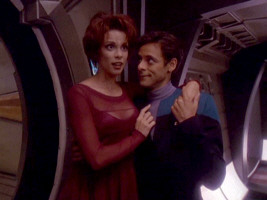
 Bashir in DS9: "Let He Who Is Without Sin..."
Bashir in DS9: "Let He Who Is Without Sin..."